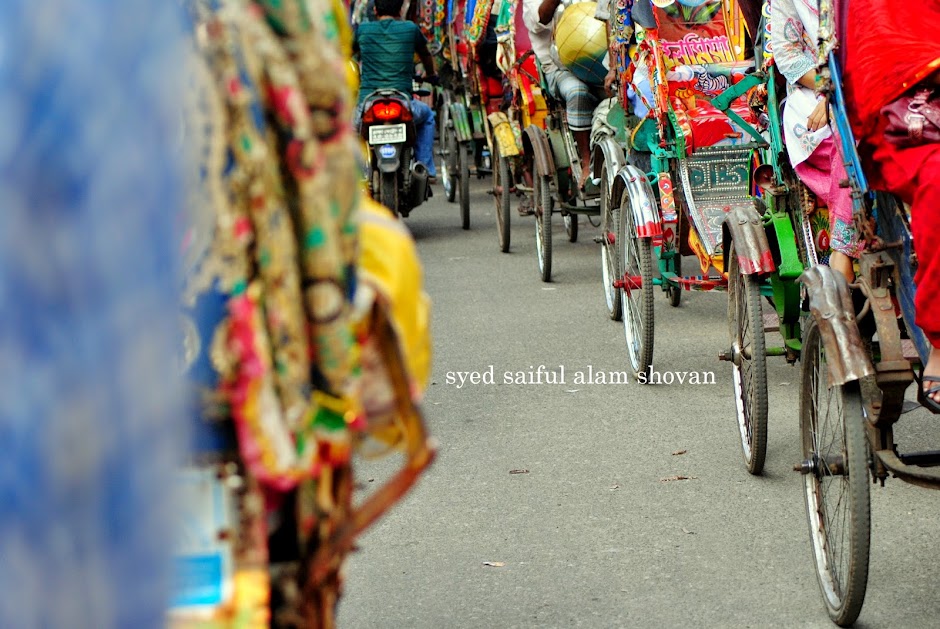Rickshaws are in many ways the ideal form of transport
They provide door-to-door transport at all hours and in all weather, emit no fumes, create no noise pollution, use no fossil fuels, and employ large numbers of the poorest people.
It is not the rickshaws that are clogging the streets; it's the cars. In 1998, the less than 9% of vehicular transport by car required over 34% of road space, while the 54% travelling by rickshaw took up only 38% of road space. The solution is not to reduce rickshaw transport, but to prevent the growth of car use, by minimising the road space and parking space allocated to cars.
In addition, there are many simple solutions that could benefit both the rickshaw-riding majority and the car-owning minority. Instead of banning rickshaws, the World Bank and local authorities could be (a.) providing dedicated lanes and cycle rickshaw stations that would prevent conflicts between modes, (b.) implementing a programme to help improve the quality of the rickshaws, (c.) supporting cycle rickshaw drivers with training, uniforms, tariff standardisation, etc., (d.) creating cycle lanes throughout the city, and (e.) supporting public transit through bus-only lanes, bus-only turns, etc.
Many rickshaw pullers fled from starvation in the villages. With exceptionally bad floods this year, many villages lack sufficient food and seeds. Cutting back on rickshaw income means directly attacking the ability of the poorest and most vulnerable to survive - not just the rickshaw pullers themselves, but the families and entire villages that they support.
The Mirpur Road is a disastrous choice for a rickshaw ban, as there are no alternate roads for rickshaws, and it is extremely difficult to walk on this road because of the prevalence of street vendors.
Accommodating the automobile over other modes is undemocratic, supporting a wealthy elite while the majority suffers. In the long run, even the rich will not benefit from rickshaw bans, as current policies will lead to more traffic jams, dirtier air and increased noise pollution.
The World Bank figure that the rickshaw ban will cover "only 6% of roads" is highly misleading. Maybe 6% of roads, but those corridors carry well over 50% of all the traffic in the city. Further, the figure of 6% is misleading because Dhaka has only a small number of arterial roads which due to the lack of a secondary road network means must carry all kinds of traffic, including short trips by pedestrians and rickshaws as well as longer trips by motor vehicles. The proposed restrictions cover almost all the main arterials (the widest roads in Dhaka), and almost all of the north-south corridors, where a large percentage of the overall traffic occurs. The rickshaw-ban roads are almost all in the range of 25 metres to 45 metres wide (including walkways), i.e., at least three lanes in each direction. Some are even wider. So the World Bank's claim that traffic cannot be segregated on the arterial roads is simply false.
World Bank policy in Dhaka is inconsistent with the spirit of the World Bank's urban transport strategy, Cities on the Move (2001), which is highly progressive and supportive of non-motorised transport.
Rickshaws are the main source of vehicular transport for the middle class. Since there are often not alternatives within their means, a rickshaw ban is a restriction of their freedom of movement, and therefore a violation of Article 13 of the Universal Declaration of Human Rights.
While proposing for further rickshaw bans between Russell Square and Azimpur, the Dhaka Transport Coordination Board presented data showing an increase in average motor vehicle speeds (15 kmh to 24 kmh) in other parts of the same corridor where a rickshaw ban has already been imposed. But did they analyse how robust and stable the gain in speed reductions would be? Considering experiences of the other rickshaw-free roads, is it not more likely that the gain in speed would be very short lived and the extra space created would soon be filled by more motorised vehicles? And further, wouldn't a ban on motor vehicles on major roads similarly speed up the rickshaws and also allow space for bicycles and pedestrians?
www.dhaka-rickshaw.blogspot.com/ Dhaka Rickshaw
www.dhaka-transport.blogspot.com/ Pro-people Transport Plan www.dhakanewspapers.blogspot.com/ All Newspapers on one click
Syed Saiful Alam
shovan1209 [at] yahoo.com
